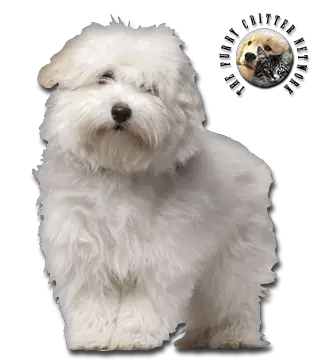Breed Standard
Head: Short, triangular when viewed from the top. Domed skull. Stop not very pronounced. Straight nosebridge. Thin lips. Black or dark reddish-tan nose.
Ears: Set on high, pendulous, thin, triangular. Covered with white or colored hair (yellow spots, a combination of yellow and black, or a few black hairs).
Eyes: Round, dark, widely spaced.
Body: Long. Muscular neck without dewlap. Well-developed chest. Loin very slightly arched, well-muscled. Standing low to the ground. Very slightly arched, well-muscled back. Rounded, broad croup.
Tail: Set on low, approximately 18 cm long, thick at the base, thin at the tip. At rest hanging below the hock with the tip raised.
Hair: Approximately 8 cm long, thin, slightly wavy, cottony.
Coat: White. Some yellow spots, particularly on the ears, are allowed.
Size: Dog: 25 to 32 cm. Bitch: 22 to 28 cm.
Weight: Dog: 4 to 6 kg. Bitch: 3.5 to 5 kg.
History
It is believed that the Tenerife dog was brought to Madagascar and mated with a dog of the island, creating an unexpected result. The Coton's ancestors were possibly brought to Madagascar in the 16th and 17th centuries aboard pirate ships. Madagascar was a haven for pirates, and pirate graveyards can still be seen there. Pirates established a base on St. Mary's Island, Madagascar and some of them took Malagasy wives. Whether the dogs were brought along to control rats on the ships, as companions for long voyages, or were confiscated from other ships as booty, no one knows. Tulear is a port now also known as Toliara. The Coton is of the Bichon dog type, linked most closely to the Bichon Tenerife, and Tenerife Terrier. There have been many stories circulating about the history of the Coton in recent years; most of them are untrue. The Coton de Tulear was never feral on Madagascar. It did not hunt wild boar or alligators, as its size, strength, and demeanor can disprove easily. It was a companion dog of the Merina (the ruling tribe) in Madagascar. It has very little prey drive, and is not a hunting dog.
In the United States, another standard for the Coton de Tulear was developed based on the breed in Madagascar in 1974 by a biologist, Dr. Robert Jay Russell, and the Coton de Tulear Club of America https://www.cotonclub.com was formed in 1976 by Russell. The American Kennel Club has offered Foundation Stock Service to the Coton de Tulear since 1996, but the Coton de Tulear Club of America is opposed to American Kennel Club recognition for its breed. As a result, many other Coton de Tulear breed clubs have been formed, accepting one or both of the standards for the breed.
Behavior
The Coton is a playful, affectionate, intelligent breed. Although generally quiet, it can become very vocal—grunting, barking, and making other noises when having fun. Cotons are known to have a habit of jumping up and walking on their hind legs to please people. Most Cotons love meeting new people and are very curious about new situations. Cotons are easy to train as they are very eager to please. Cotons love to swim, run, and play. They adapt well to any kind of living environment. A common trait of the Coton de Tulear behavior is to come alive in the evening.
The Coton has a coat that requires brushing and combing almost daily and bathing about once per week to maintain its beauty. Cotons love swimming; owners who have pools are recommended to let their Cotons play in the pool with supervision. Like poodles, they do not "shed", meaning they don't drop hair on furniture, carpeting, etc. They do lose hair; their coat's texture causes the shed hair to be trapped in the coat. If not brushed and combed daily, this breed's fur will mat up quickly and may require shaving. Cotons need a walk every day for exercise but will appreciate a play session as often as possible and have the endurance to go on a long hike. Cotons love to play with other dogs, and they are great with kids.
He can adapt to apartment life. This athlete needs baths and grooming three or four times a year.
Function
Pet.
Health
The Coton is, in general, a healthy breed. However, there are still some health issues as there are in all breeds. The most serious issues are heart problems, liver shunts, back (disc) problems, and eye problems. Luckily, these are still relatively uncommon in the breed. The small gene pool of this breed is owing to its near extinction. Due to inbreeding by disreputable breeders, there is an increased incidence of disease. The smaller the gene pool, the more likely a breed is to have genetic abnormalities.
The Coton de Tulear has few health issues compared to many other breeds due to being rather generic in type. It is a fairly rare breed and is just now being accepted and recognized by the AKC as of 2012. The fact that this is a breed being revived from extinction means that the Coton de Tulear is rather expensive to purchase, and prices may reach $1,800.00-$3,500 per dog. The average life span of a Coton de Tulear is 14 to 19 years.






